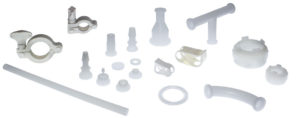What is USP Class Testing?

USP Class testing is one of the most common methods of testing to determine bio-compatibility of materials. There are six classes, VI being the most rigorous. Class VI testing is aimed to certify that there are no harmful reactions or long-term bodily effects caused by chemicals that leach out of plastic materials. USP Class Testing standards are determined by the United States Pharmacopeia and National Formulary (USP-NF), the organization responsible for the quality and safety of medical devices and foods. Class testing is frequently conducted on plastic materials that come in contact with injectable drugs and other fluids found in various steps of the drug manufacturing process.
USP Class VI Testing Methods
USP Class VI testing is conducted by producing an extract of the product with different extraction fluids, such as polyethylene glycol and vegetable oil, and injecting it in specimen (rabbits and mice) in vivo (alive), to observe the biological response to the extract. Testing is commonly done as per USP <88>, which requires three types of testing: systemic injection, intracutaneous, and implantation.
- Systemic Injection Test (Acute Systemic Toxicity):
Test specimen are injected with the extract intravenously and observed for 72 hours. The specimen are monitored for any abnormal toxic reactivity. The scientist determines the test as pass/fail. - Intracutaneous Test:
The purpose of this test is to check for any local skin reactions. Test Specimen are injected with the extract intracutaneously and observed for 72 hours. The reactions are scored and averaged. - Implantation Test:
Specimen are implanted with the product material to observe the reaction of the live tissue in direct contact with the product over a span of at least 120 hours (5 days).
Why should products be USP Class VI?
Class testing is often required for manufacturing drugs for its low toxicity compliance and strict bio-compatibility standards. It is important to know that no fluid-contact surfaces will result in harmful chemicals being extracted in to a conveyed fluid. Class VI testing extensively investigates the reaction in the body, skin, and living tissue to ensure safety. USP Class VI is a common standard for pharmaceutical tubing, fittings, single-use systems, and fabricated parts.
